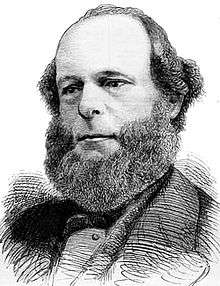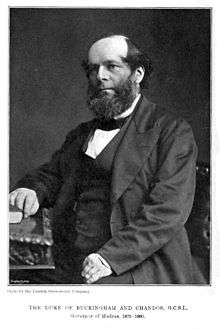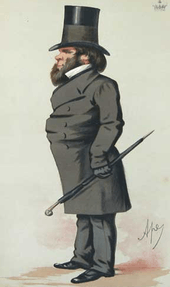Richard Temple-Nugent-Brydges-Chandos-Grenville, 3rd Duke of Buckingham and Chandos
| His Grace The Duke of Buckingham and Chandos GCSI PC DL | |
|---|---|
 The Duke at the time of his appointment as Governor of Madras in 1885 | |
| Governor of Madras Presidency | |
|
In office 23 November 1875 – 20 December 1880 | |
| Governor-General |
Thomas Baring, 1st Earl of Northbrook, Robert Bulwer-Lytton, 1st Earl of Lytton, George Robinson, 1st Marquess of Ripon |
| Preceded by | William Rose Robinson (acting) |
| Succeeded by | William Patrick Adam |
| Lord President of the Council | |
|
In office 6 July 1866 – 8 March 1867 | |
| Monarch | Victoria |
| Prime Minister | The Earl of Derby |
| Preceded by | The Earl Granville |
| Succeeded by | The Duke of Marlborough |
| Secretary of State for the Colonies | |
|
In office 8 March 1867 – 1 December 1868 | |
| Monarch | Victoria |
| Prime Minister |
The Earl of Derby Benjamin Disraeli |
| Preceded by | The Earl of Carnarvon |
| Succeeded by | The Earl Granville |
| Personal details | |
| Born | 10 September 1823 |
| Died |
26 March 1889 (aged 65) Chandos House, Marylebone, London |
| Nationality | British |
| Political party | Conservative |
| Spouse(s) |
(1) Caroline Harvey (d. 1874) (2) Alice Graham-Montgomery (1847-1931) |
| Alma mater | Christ Church, Oxford |
Richard Plantagenet Campbell Temple-Nugent-Brydges-Chandos-Grenville, 3rd Duke of Buckingham and Chandos GCSI PC DL (10 September 1823 – 26 March 1889), styled Earl Temple until 1839 and Marquess of Chandos from 1839 to 1861, was a British soldier, politician and administrator of the 19th century. He was a close friend and subordinate of Benjamin Disraeli and served as the Secretary of State for the Colonies from 1867 to 1868 and Governor of Madras from 1875 to 1880.
Buckingham was the only son of Richard Temple-Grenville, 2nd Duke of Buckingham and Chandos, and was educated at Eton and Christ Church, Oxford. He joined the British Army, eventually rising to become a colonel. Buckingham entered politics, as Lord Chandos, in 1846 when he was elected unopposed from Buckinghamshire as a candidate of the Conservative Party. Buckingham served as Member of Parliament from 1846 to 1857, when he resigned. He contested a re-election in 1859, but lost. Buckingham served in various political offices during his tenure. In March 1867, he was appointed Secretary of State for the Colonies and served until December 1868. He also served as Governor of Madras from 1875 to 1880. As Governor, he handled the relief measures for the victims of the Great Famine of 1876-78. Buckingham also served as Lord of the Treasury, Keeper of the Privy Seal of the Prince of Wales, Deputy Warden of the Stannaries, Deputy Lieutenant of Buckinghamshire, Chairman of the London and North-Western Railway, member of the Imperial Privy Council, Lord President of the Council and chairman of the committees in the House of Lords. He died on 26 March 1889 at the age of 65.
Background and education
Buckingham was born the only son of Richard, 2nd Duke of Buckingham and Chandos, and his wife Lady Mary, younger daughter of John Campbell, 4th Earl of Breadalbane and Holland (later The 1st Marquess of Breadalbane). As his father's son and heir apparent, he was styled Earl Temple from birth. He was 15 years of age when his paternal grandfather died and his father became the 2nd Duke of Buckingham and Chandos. From this time onwards, he was styled Marquess of Chandos until he succeeded his father as Duke.
The young Lord Temple, later Lord Chandos, attended Eton until 1841 and graduated from Christ Church, Oxford. Two years after graduation, Lord Chandos (as he then was) was commissioned a Lieutenant in the Royal Buckinghamshire Yeomanry and he would eventually become Honorary Colonel of that regiment. He was also Hon Colonel of the 1st Administrative Battalion, Middlesex Artillery Volunteers and later of the City of London Artillery.[1]
Early career

In 1846, Buckingham, as the Marquess of Chandos, entered Parliament as Conservative MP for Buckinghamshire, and remained as an unopposed MP until 1857. The young Lord Chandos was appointed a deputy lieutenant for Oxfordshire on 3 February 1846,[2] Hampshire on 17 February,[3] and Northamptonshire on 29 May.[4] In 1852, he entered Lord Derby's administration as a Lord of the Treasury, a position he held for exactly ten months. That year, he was also appointed Keeper of the Privy Seal of the Prince of Wales,[5] Deputy Warden of the Stannaries, deputy lieutenant of Buckinghamshire,[6] and chairman of the London and North-Western Railway. In 1857, he resigned as MP for Buckinghamshire and did not stand for re-election due to the deteriorating family fortunes and his father's bankruptcy. In 1859, Lord Chandos contested against William Ewart Gladstone for the constituency of Oxford University, but lost by 859 to 1,050 votes. In 1861, he succeeded his father as Duke of Buckingham and Chandos (and in various other titles across four Peerages) and took his seat in the House of Lords; he also resigned as chairman of the London and North-Western Railway. In the 1860s he was chairman of the London Pneumatic Despatch Company.
Buckingham's political career was stagnant until 1866, when he was appointed to the Privy Council and became Lord Derby's Lord President of the Council. During the interregnum, Buckingham served as chairman of the executive committee of the royal commission for the Great Exhibition of 1862. He served as Lord President of the Council until 8 March 1867, when he succeeded Lord Carnarvon as Secretary of State for the Colonies.
As Secretary of State for the Colonies
Buckingham was appointed Secretary of State for the Colonies when Lord Carnarvon resigned in March 1867 over the Reform Bill and served from 8 March 1867 to 1 December 1868. During this period, he was also appointed Lord Lieutenant of Buckinghamshire. As Secretary of State for the Colonies. Buckingham had to deal with the British North America Act. He also attracted controversy over his dispute with Bishop Colenso of Natal. Buckingham's tenure ended in December 1868 when the Conservative Party ministry of Benjamin Disraeli resigned. He was succeeded as Colonial Secretary by Lord Granville.
In 1868, in the House of Lords, he established his right to the title of Lord Kinloss in the Peerage of Scotland, which had been dormant.
Governor of Madras


%2C_Trivandrum_1880%2C_painted_by_Raja_Ravi_Varma.png)
When the Conservative Party was re-elected to power in the United Kingdom in 1874 and Disraeli became the Prime Minister once again, Buckingham was appointed Governor of the Madras Presidency, British India. Buckingham moved to Madras and took his seat on 23 November 1875.
Buckingham served as the Governor of Madras from 1875 to 1880. His tenure was plagued by deteriorating socio-economic and health conditions. In 1876, the Great Famine of 1876–78 broke out in Madras Presidency. By August 1877, the famine had spread all over the Presidency and over 18 million people were affected.[7] To make matters worse, the rains failed in parts of Madras and Mysore.[7] Large quantities of grain were shipped from Bengal to Madras port.[7] The Governor appealed to the principal cities of England, Scotland, Ireland and India for assistance.[7] At Buckingham's suggestion, the Lord Mayor of London collected relief funds of up to £475,000. Though the famine eventually came to an end in 1878, the issue had far-reaching effects.
As a part of the famine relief work, Buckingham had commenced the construction of a navigation channel between Madras city and the northern part of the Madras Presidency so that transportation of supplies to the interior in cases of emergency would be easy. Opened in 1878, this canal was named after Buckingham as Buckingham Canal.
Displeasure of the tribes of the northern part of the Presidency over the stringent taxation schemes of the British government erupted in the form of the a major rebellion in 1879. The rebellion was eventually suppressed through a joint operation of the Madras police and army and the Hyderabad army and the captured prisoners sent to the Andamans. Many of the stringent taxation laws were repealed.
On 30 August 1880, William Patrick Adam was appointed Governor of Madras[8] and he succeeded Buckingham in December 1880.
Later life
In May 1886, Buckingham succeeded Lord Redesdale as Chairman of Committees in the House of Lords. He made few speeches in the House of Lords and succeeded in paying off most of his father's debts. Gradually, towards the later part of his life his financial situation improved and by 1883, he owned 10,482 acres of land with a total value of £18,080.
Buckingham died in March 1889, aged 65, from an unknown illness at Chandos House, London. With no male issue, the dukedom of Buckingham and Chandos became extinct, although several of his lesser titles survived due to special remainders: his nephew William Gore-Langton succeeded him in 1892 as fourth Earl Temple of Stowe; his eldest daughter Lady Mary succeeded him in the Scottish lordship of Kinloss and his distant relative Charles Lyttelton succeeded him as Viscount Cobham.
Family

Buckingham married firstly Caroline Harvey, daughter of Robert Harvey, in 1851. They had three daughters:
- Mary Morgan-Grenville, 11th Lady Kinloss (1852–1944)
- Anne (1853–1890)
- Caroline Jemima Elizabeth (1858–1946)
Caroline, Duchess of Buckingham and Chandos, died in February 1874.
Buckingham married, secondly, Alice Graham-Montgomery, daughter of Sir Graham Graham-Montgomery, 3rd Baronet, in 1885. In 1897, she was one of the guests at the Duchess of Devonshire’s Diamond Jubilee Costume Ball.[9]
There were no children from this marriage. Widowed in 1889, Alice, Dowager Duchess of Buckingham and Chandos, married the 1st Earl Egerton in 1894. She died in 1931, aged 83.[10]
References
- ↑ Army List
- ↑ The London Gazette: no. 20568. p. 411. 6 February 1846.
- ↑ The London Gazette: no. 21297. p. 670. 24 February 1846.
- ↑ The London Gazette: no. 20609. p. 1981. 29 May 1846.
- ↑ The London Gazette: no. 21303. p. 869. 23 March 1852.
- ↑ The London Gazette: no. 21341. p. 2012. 20 July 1852.
- 1 2 3 4 "THE FAMINE IN INDIA: A FAMINE AREA OF EIGHTEEN MILLION PEOPLE--THE NECESSITY FOR SUPPLIES STEADILY INCREASING--THE SITUATION CRITICAL". The New York Times. 12 August 1877.
- ↑ "Current Foreign Topics". The New York Times. 31 August 1880.
- ↑ Walker, Dave. "Costume Ball 4: Ladies only". Royal Borough of Kensington and Chelsea.
- ↑ http://www.mytrees.com/ancestry-family/jo004502-6891-48297/Alice-Graham%20Montgomery-Born-1848.html
External Info
- Partha Mitter, Art and Nationalism in Colonial India, 1850-1922, Cambridge 1994, 179-218.
- E. Neumayer and C. Schelberger (ed., with a foreword by Partha Mitter), Raja Ravi Varma, Portrait of an Artist: the Diary of C. Raja Raja Varma, New Delhi 2005.
- Messrs. Jackson Stops, The Ducal Estate of Stowe: Sale of the Contents of the Mansion, 5th-28th July 1921.
- J. Beckett, The Rise and Fall of the Grenvilles, Dukes of Buckingham and Chandos 1710 to 1921, Manchester 1994.
- M. Bevington, Stowe House, London 2002.
External links
| Wikimedia Commons has media related to Richard Temple-Grenville, 3rd Duke of Buckingham and Chandos. |
| Wikisource has original text related to this article: |
- Leigh Rayment's Peerage
- The Dukes of Buckingham
- Hansard 1803–2005: contributions in Parliament by the Duke of Buckingham and Chandos
- Portraits of Richard Grenville, 3rd Duke of Buckingham and Chandos at the National Portrait Gallery, London

- "Archival material relating to Richard Temple-Nugent-Brydges-Chandos-Grenville, 3rd Duke of Buckingham and Chandos". UK National Archives.